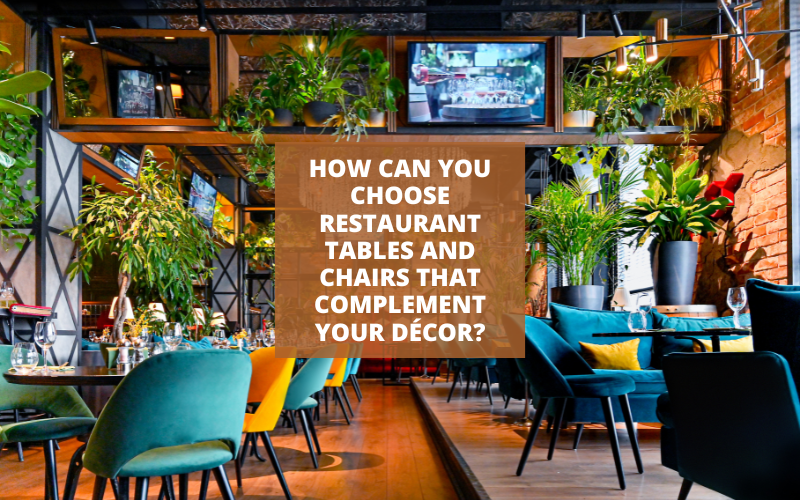
Choosing the right restaurant tables and chairs is crucial for creating a memorable dining experience. The furniture you select not only needs to be functional but also harmonize with the overall décor of your establishment. This article will guide you through the essential factors to consider when selecting tables and chairs that complement your restaurant’s décor.
Understanding the Role of Restaurant Furniture
NOTE: Restaurant Tables and Chairs were expertly selected to match our client’s unique décor. SDFGroups ensured every piece complemented the ambiance perfectly. Discover how our tailored solutions can transform your space—contact SDFGroups today for a consultation!
The Importance of Aesthetic Harmony
Restaurant furniture plays a significant role in setting the tone of the dining environment. The tables and chairs should seamlessly blend with the restaurant’s theme, creating a cohesive look that enhances the overall ambiance. The right choice of furniture can elevate the dining experience, make your restaurant more inviting, and help in establishing your brand identity.
Functional Considerations
Beyond aesthetics, functionality is key. Furniture must be durable, easy to maintain, and comfortable for guests. It should also fit the spatial layout of your restaurant, allowing for smooth traffic flow and accessibility.
Assessing Your Restaurant’s Décor Style
Identifying Your Theme and Concept
Before selecting furniture, clearly define your restaurant’s theme and concept. Whether it’s a contemporary bistro, a classic diner, or a luxurious fine-dining establishment, the furniture should reflect and enhance your chosen style.
- Modern/Contemporary: For a sleek, modern look, opt for minimalist designs with clean lines and neutral colors. Materials like glass, metal, and polished wood often work well.
- Classic/Traditional: Classic establishments benefit from timeless designs. Think rich wood finishes, ornate details, and plush upholstery.
- Rustic/Industrial: If your restaurant has a rustic or industrial theme, consider reclaimed wood, metal, and distressed finishes.
- Eclectic/Bohemian: For an eclectic feel, mix and match various styles, colors, and materials to create a unique and vibrant atmosphere.
Matching Furniture to Color Schemes
The color scheme of your restaurant can influence the choice of furniture. Coordinate the colors of tables and chairs with your restaurant’s palette. For instance, if your décor features bold, vibrant colors, choose furniture that complements or contrasts effectively without overwhelming the space.
Choosing the Right Materials
Wood
Wood is a classic choice for restaurant furniture, offering warmth and durability. Different types of wood can lend varying looks:
- Oak and Maple: These hardwoods are known for their durability and are often used in traditional or contemporary settings.
- Cherry and Walnut: These offer a richer, more elegant appearance and are ideal for upscale establishments.
- Reclaimed Wood: Perfect for rustic or industrial themes, adding character and sustainability to your décor.
Metal
Metal furniture can provide a modern, industrial, or even retro vibe. It’s highly durable and easy to clean, making it suitable for high-traffic areas.
- Stainless Steel: Sleek and modern, ideal for contemporary designs.
- Wrought Iron: Adds a touch of classic or rustic charm.
- Aluminum: Lightweight and versatile, suitable for various styles.
Upholstery
Upholstered chairs add comfort and style. Choose materials that are both aesthetically pleasing and practical for the restaurant environment.
- Leather: Durable and easy to clean, offering a luxurious feel.
- Fabric: Offers a range of textures and colors but requires more maintenance.
- Vinyl: A practical alternative to leather, with easy cleaning and a similar appearance.
Ensuring Comfort and Functionality
Ergonomic Design
Comfort is a top priority. Ensure that the chairs provide adequate support and are comfortable for prolonged sitting. Ergonomic designs can enhance the dining experience and encourage longer stays.
Size and Dimensions
Select tables and chairs that fit well within your space. Consider the following:
- Table Height: Standard table height is usually 28-30 inches. Ensure it allows for comfortable seating.
- Chair Height: The seat height should be approximately 10-12 inches lower than the table height.
- Spacing: Maintain adequate spacing between tables to ensure ease of movement and compliance with fire and safety regulations.
Durability and Maintenance
Restaurant furniture must withstand heavy use. Choose materials that are resilient and easy to clean. For example:
- Scratch-Resistant Surfaces: Ideal for high-traffic areas.
- Stain-Resistant Upholstery: Helps maintain a clean appearance with minimal effort.
Matching Tables and Chairs: Design Tips
Style Coordination
While your tables and chairs should complement each other, they don’t have to match exactly. Use complementary styles or finishes to create visual interest. For instance, a rustic table with sleek, modern chairs can create a dynamic contrast.
Color and Finish

Ensure the color and finish of the furniture align with your overall décor. If your restaurant features a neutral color scheme, you might choose bold furniture pieces to add a pop of color.
Shape and Arrangement
Consider the shape of your tables and chairs. Round tables can create a more intimate atmosphere, while rectangular tables are suited for larger groups. The arrangement should facilitate smooth traffic flow and align with the layout of your space.
Integrating Branding and Personalization
Custom Furniture
Custom-designed furniture can help reinforce your brand identity. Work with designers to create pieces that reflect your restaurant’s personality and enhance the dining experience.
Logo and Branding
Incorporating your logo or brand colors into the furniture can strengthen brand recognition. For example, custom upholstery or engraved table tops can subtly display your brand.
Conclusion
Choosing the right restaurant tables and chairs is a critical aspect of designing an inviting and functional dining space. By considering your restaurant’s décor style, material choices, comfort, and functionality, you can create a cohesive and enjoyable environment for your guests. Investing time and thought into selecting complementary furniture will pay off in enhancing the overall dining experience and reflecting your brand’s identity.
By following these guidelines, you’ll be well on your way to furnishing your restaurant with pieces that not only complement but also elevate your décor, ensuring a lasting impression on every guest.
For More Isightful Articles Related To This Topic, Feel Free To Visit: smallbizblog